We independently evaluate all recommended products and services. Any products or services put forward appear in no particular order. If you click on links we provide, we may receive compensation.
Hogue is one of the lesser-known brands when it comes to knives, but it’s a household name in the gun world, where they’re renowned for their high-quality grips and accessories. That seems to be slowly changing thanks to their innovative line of in-house-produced knives which are of almost universally excellent quality – hardly the norm for “gun branded knives” as anyone who’s handled a Smith & Wesson knife can attest.

Part of the allure of Hogue’s knives is who designs them – that being Allen Elishewitz. Elishewitz has been in the knife industry for a long time (since 1988, and a member of the American Knifemaker’s Guild since 1994) and has done production collaboration work with brands like Benchmade and CRKT. Hogue tapping his considerable design skills for their line of knives was a great choice, as it gives them a cohesive design language (like the wild EX-04 we tested) and recognizable brand identity.
The X-1 Microflip is a new addition to the Hogue lineup, along with the X-1 Microswitch, which is an automatic version of the same. The Microflip is a manual flipper that packs an interesting surprise under the skin, along with premium materials and high-grade construction in a small package – it’s the smallest folder Hogue has made with a 6.625” overall length open. Let’s check out the highs and lows of this unique knife.
Key Specs: Hogue X-1 Microflip
The Blade
The X-1 Microflip gets the “micro” part of its name from the diminutive blade length. Coming in at only 2.625” long, the Microflip is very much a handle-heavy design, with a 4” long handle. Unusually for a Hogue the blade shape is pretty conventional, a utilitarian drop-point with a high flat grind and a half-swedge along the spine. It’s also available as a wharncliffe with a straight sharpened edge for more of a utility slant.
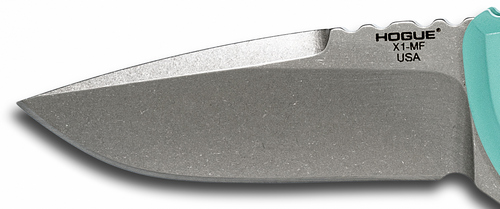 Blade stock is a reasonable 0.12” thick, and the blade has a smooth stonewashed finish to it. The blade is just long enough to be useful for day-to-day tasks, helped no doubt by its utilitarian drop point shape. There’s a very well-executed sharpening choil at the base of the cutting edge, neatly terminating the sharpened portion without any “heel” allowing you to sharpen the whole length of the edge.
Blade stock is a reasonable 0.12” thick, and the blade has a smooth stonewashed finish to it. The blade is just long enough to be useful for day-to-day tasks, helped no doubt by its utilitarian drop point shape. There’s a very well-executed sharpening choil at the base of the cutting edge, neatly terminating the sharpened portion without any “heel” allowing you to sharpen the whole length of the edge.
Blade steel here, like most all of Hogue’s other knives, is CPM-154. CPM-154 is the powdered-metallurgy variant of the more common 154CM with a remarkably simple makeup, the only additional elements being carbon, chromium and vanadium. Carbon content is 1.05%, making it slightly higher than CTS-BD1 but about 2/3 of S30V. Chromium is fairly high at 14% (identical to S30V and slightly lower than BD-1) and it has a high dose of Molybdenum at 4% for a fine grain structure. 154CM has always been a great go-to stainless steel for knives, and the finer grain structure of CPM154 just makes it even sweeter when it comes to sharpening.
Deployment and Lockup
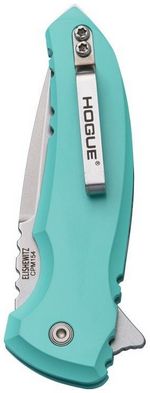 So here’s the interesting aspect of the X-1 Microflip: the deployment. The X-1 (like a lot of Hogue models) uses a button lock, also called a plunge lock, which is most common on automatic knives. With an automatic knife, all the button is doing is holding the blade closed or open, and when it’s depressed it allows the stored tension of the coiled spring to snap the blade open – there’s no detent to it, it is very much a digital device in that it’s either on or off.
So here’s the interesting aspect of the X-1 Microflip: the deployment. The X-1 (like a lot of Hogue models) uses a button lock, also called a plunge lock, which is most common on automatic knives. With an automatic knife, all the button is doing is holding the blade closed or open, and when it’s depressed it allows the stored tension of the coiled spring to snap the blade open – there’s no detent to it, it is very much a digital device in that it’s either on or off.
This means that button locks usually go with flipper openers like peanut butter and salmon – you need a pronounced detent to make a flipper work elegantly. This is the same reason the Benchmade 300 series is such a mediocre flipper – there’s no detent to build pressure up against before the knife flips open, requiring a wrist flick to make it happen.
Hogue’s solution to this problem is quite clever. They use a “detent plate” mounted on the handle side opposite the plunge lock, with a fixed stainless ball detent. The detent travels in a groove cut in the tang of the blade that gradually ramps upwards as it curves around the pivot towards the closed direction. As you close the knife, the blade pushes the detent outwards on its steel plate, acting as a spring, until it drops down into the closed position, tightly holding the knife shut.
This makes for an extremely strong detent, probably one of the hardest detents of any flipper in recent memory. So the X-1 flips very hard once you overcome that detent. It is impossible to “misfire” the X-1, or open it partially on a flip, owing to this detent system. What’s interesting is there are no separate washers – just raised portions around the pivot on the inside of the handle to center the blade. It comes off as a strong exercise in machining capability, and it certainly works – this knife opens wicked fast every time, but it’s not perfect.
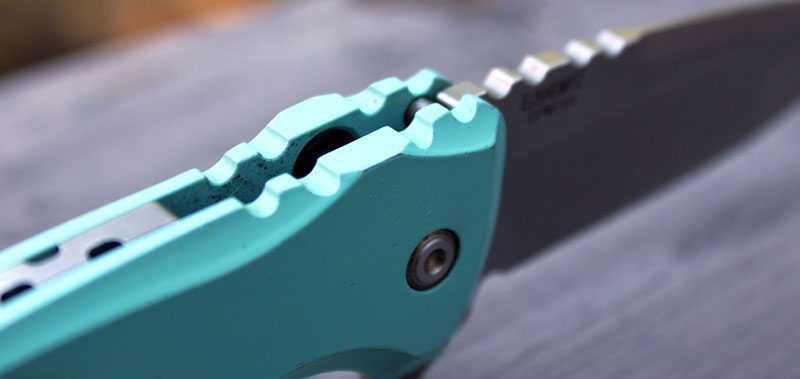
I don’t mean to come off sounding like a soft-handed desk jockey, but this detent is too stiff. Casual knife users might have difficulty opening it safely. My wife was enamored with the color of the X-1 and wanted to try it out, but the learning curve of the flipper was substantial. Also, it feels a lot like an assisted opening knife when you close it, only in reverse. When pushing the release for the plunge lock, it will free drop about 2/3 of the way shut before it meets resistance from the detent plate, requiring a firm pull to close. I’ve always felt that this extra effort makes assisted open and automatic knives less safe to operate, and I feel the same way about the X-1. But this is a clever solution to a problem, and it absolutely opens well.

Lockup is perfect. Hogue has their button locks dialed in perfectly, with a break-in period of maybe 50 flips before any lock stick disappeared. The X-1 uses an external stop pin to locate the blade in the open position (ideal for strength) so the plunger merely holds the blade open, and it releases perfectly smooth every time. An advantage of a plunge lock is the ability to keep your fingers out of the blade’s path when closing, like Spyderco’s compression lock.
Features, Fit & Finish
The thing that stands out the most about the Hogue’s fit and finish is the edge this knife arrived with from the factory. It has a literal mirror polish, able to cleanly reflect images if held at the right angle, and is by far the nicest factory edge on any knife I’ve ever seen. The big domestic manufacturers don’t put this kind of attention into sharpening. It was almost a shame to use it, but I’m glad I did, because it came light-saber sharp. Whoever is doing the sharpening at the Hogue factory deserves a raise and a reserved parking spot.
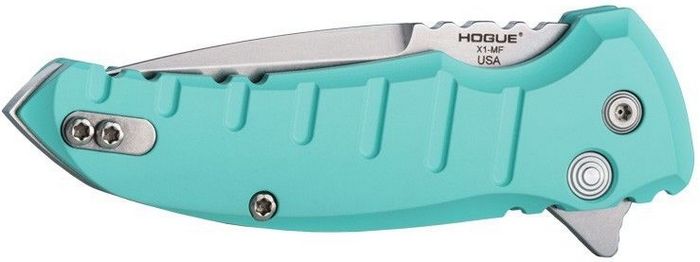
Fit and finish on my test sample was generally very good, not surprising for a Hogue product. There’s a lot of machining in the aluminum handles, including a radiused edge that changes depth drastically as it goes around the circumference of the handle, as well a few runs of rounded jimping. A minor detail that might at first seem like a misstep in fitting is how the backspacer protrudes from the spine at the very rear – but it seems to be done purposefully to allow the pommel to be used as a punch or striking instrument.
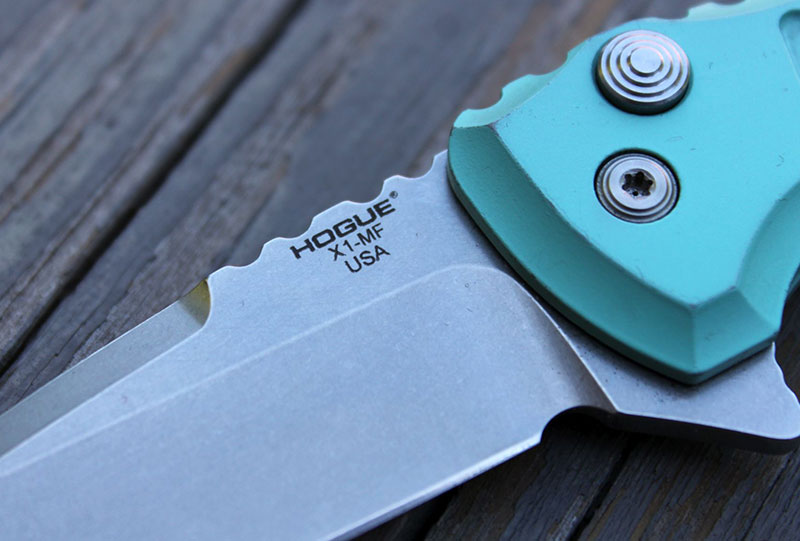
The X-1 is a visually arresting knife, seemingly crammed with details and styling elements till it’s fit to burst. The most obvious is the handle color: while the knife is available in a variety of colors, my test sample came in matte aquamarine, which is… very bright. If you’re not such an extrovert, you can get the X-1 in normal colors like black, matte grey, and flat dark earth, but where’s the fun in that? The Aqua X-1 is one of very few knives that my wife took an immediate liking to, primarily due to the vibrant color.

The clip is interesting, with a recessed mount anchored by two in-line screws, and the tip folded over like a ball point pen. There’s a blanking plate and additional screws on the unused side of the handle, a la Hinderer. Another fascinating detail are the staggered holes cut into the outer edges of the backspacer, making it look like a piece of Swiss cheese. A set of diagonal grooves are cut into the lock side of the handle for added grip as well.
Field Test
There are several great things about using the Hogue X-1, but sadly there are some bad things too.
Most noticeable is the durability (or lack thereof) of the matt aquamarine paint coating, which began flaking off shortly after I started carrying the knife, especially around the tail end aft of the clip and the leading edge of the front bolster. This wasn’t during hard use or being subjected to chemicals, just pocket carry, so the delaminating paint is confusing. I don’t know if this is an issue that will affect the other paint colors or not, but Hogue could consider a stronger coating for the X-1 line – or maybe a layer of clearcoat on top.
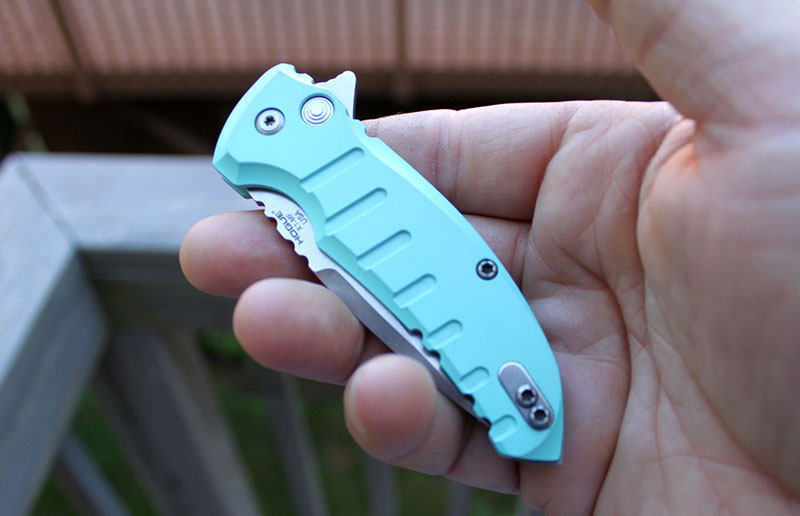
Jimping is great right up until it’s not, and when there’s aggressive jimping on the portion of the spine where your finger lands after flipping – it’s not. The wide jimping cut into the back of the handle above the lock button is of questionable utility in the first place – to me it’s much more useful on the spine of the blade – but the natural path your finger follows as it flips the knife open has you pulling your fingernail across it every time you open the knife, which has lead to my nail chipping a few times – and I don’t have “fancy” nails of any sort. It’s an odd oversight. No such complaints about the jimping on the underside of the handle where your pinky rests, which is effective and well place, and when you have a full grip on the knife your thumb naturally rests on the run of jimping on the spine.
Ergonomics are actually quite good for a smaller knife thanks to the proportionally long handle, with a forefinger choil in the handle behind the flipper tab which does a good job as a finger guard when open. The curvature of the underside of the handle places your fingers securely, and there aren’t any noticeable hot spots – the pocket clip’s flat profile thanks to that folded-over tip means it doesn’t create any high spots in your grip.
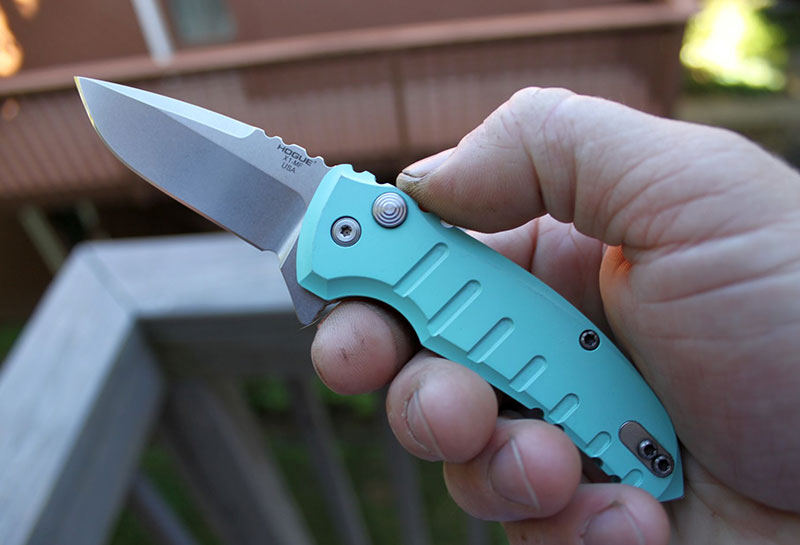
It carries okay. At a touch under 3 ounces (thanks to the size and the aluminum handles) it’s not going to drag down your shorts, and the rounded tip of the clip makes it easy to slide in and out of your pocket. Clip tension is good but the low-friction painted surface the clip rests on means that it can slide easily on thinner materials, and it tends to “pendulum” a little bit from side to side – allowing the pointy flipper tab to poke other things in your pocket.
In use, the X-1 feels like just the right size for most tasks, and being handle heavy it’s easy to control and use. The tip of the blade is noticeably above the centerline of the handle, which makes it unwieldy for food prep but just fine for utility tasks. The blade stock is a little thick relative to the height so it feels slightly fat behind the edge, but the flat grind and the stonewash finish keep friction to a minimum, and as mentioned above the edge that came on this knife was absolutely superb. Tip geometry is well thought out, a nice narrow angle for piercing but with the spine flaring out slightly towards the tip for strength.
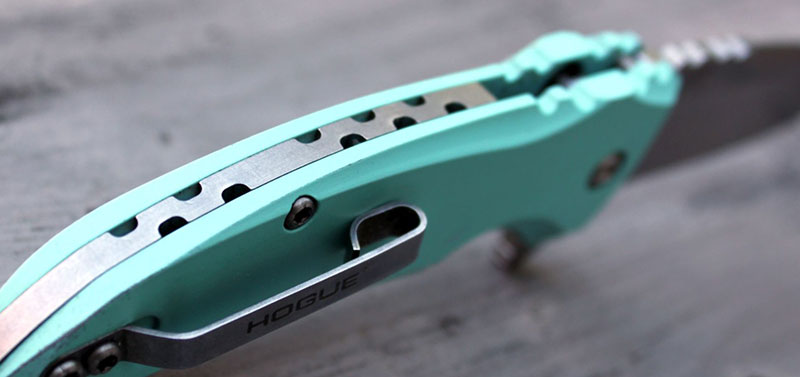
The short and stout nature of the blade makes it great for popping zip ties and cutting open packaging, where the relatively short blade length doesn’t have a negative effect at all. CPM-154 is a really nice steel – it’s very much like 154CM in performance and edge retention but it takes a much cleaner edge easier in my experience.
I didn’t have a need to disassemble the X-1 during my evaluation of it, which is good because putting a button lock knife back together can sometimes be a challenge. It does use standard Torx fittings for the body and clip screws as well as the pivot screw.
Alternatives
All these knives available at BladeHQ.
There are more competitors in this market space than there used to be, but it still isn’t exactly saturated with high-end knives under 3” of blade length. The X-1 Microflip retails for $135 at the time of writing on BladeHQ and a little cheaper on AmazonTwo knives from Spyderco come to mind, the L’il Native (BladeHQ / Amazon) with the compression lock and the Para 3 (BladeHQ / Amazon). I really wasn’t in love with the Para 3 when I reviewed it, but sales numbers don’t like and it’s been a massive hit for the company. Both offer the excellent Compression Lock, the L’il Native packing a 2.5” long full flat ground leaf shaped blade while the Para 3 has a 3” flat ground clip point blade like a baby PM2. At $120 or less they’re both cheaper than the X-1 by a few bucks, and offer CPM-S30V steel.

The WE Knife Rectifier is also worth a look. It comes in around $10 more than the Hogue, but it offers an upgrade to CPM S35VN steel, and it’s a titanium framelock with a G10 show side scale. A ball bearing pivot and a flipper do the opening for the 2.95” blade, a surprisingly conventional (For WE) drop point with a long swedge. It comes in three colors (black, tan, green) as well as regular satin or two-tone blade finishes.

Most knives from Kizer are bigger, but there are two interesting options. The first is the Feist (BladeHQ / Amazon) , a knife I’ve been carrying for a bit (review here) that has a front flipper and cleaned, minimalist lines. Nice details abound: a rounded spine makes for a comfortable grip, contoured scales feel great in the hand, and a ball bearing pivot with a steel lockbar insert make for great action and lockup. With a 2.8” blade and 2.7 ounce weight it’s similar in dimensions to the X-1, but a little slimmer and dressier. There’s also the Degnan Guru, also with all titanium construction and a 3” sheepsfoot blade. Both are pricier than the X-1 at around $170, but they have supremely good build quality.

Another fascinating knife around this size is the Viper Lille, $165-$175 depending on colors. It only has a 2.5” blade, but features a pronounced belly for roll cuts. Blade steel is Bohler M390, top of the heap for stainless steels, and the Lille has a flipper tab as well as a thumb hole for opening. The distinct style comes from Jesper Voxnaes, who’s designed quite a few knives at this point.
Wrap-Up
I can definitely appreciate what Hogue was going for with the X-1. It’s nice to see high-end construction and materials brought to a smaller size, and at no point during carrying the X-1 did I ever wish it had a longer blade. 2.75” is just enough for most tasks, without every feeling unwieldy. It’s a cool looking knife that attracted a lot of positive attention, and like everything else from Hogue it’s very well made.
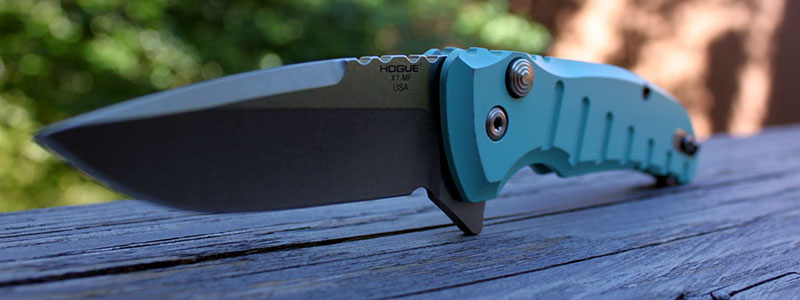
That said, the hyper-strong detent and the sprung detent plate require a bit of a learning curve, the jimping under the “landing zone” for the flipper should be ditched, and the cool Aquamarine finish proved to be far too fragile for a daily carry knife. Still, if you want something small, different, and American made, the X-1 is a good choice.
- Impressive action with a button-lock for a flipper thanks to clever detent spring plate, best factory edge I’ve ever seen, great size for EDC use, unconventional, everyone loves the color, my wife stole it.
- The color flakes off easily, ultra-stiff detent makes opening tricky, spring plate makes closing tricky, my wife stole it.
Hogue X-1 Microflip
Quality/Performance - 77%
Value for Money - 74%
76%
The X-1 is a decent effort from Hogue. Charmingly unconventional with a few flaws.





